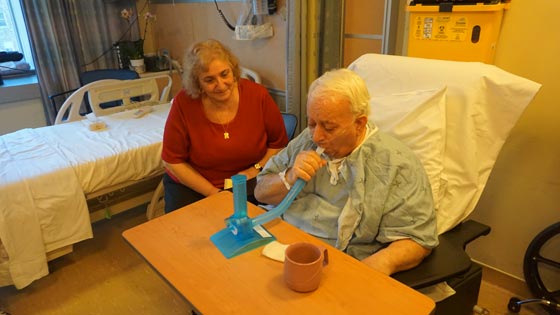
Rosa-Alba Ferraro watches as her husband of 46 years, Domenic, works to strengthen his breathing following heart surgery. She and other family members have spent 12-17 hours per day at the Peter Munk Cardiac Centre supporting Domenic’s recovery. (Photo: PMCC)
There have been two constants throughout Domenic Ferraro's gruelling 16-year medical journey through the Peter Munk Cardiac Centre (PMCC): family and faith.
His family – wife of 46 years and two adult sons have spent an average of 12-17 hours per day at the hospital since he arrived here in January 2016.
"We made a promise, as long as you are here, we will be with you 24-7," says son Sandro.
This family of great faith celebrated the most holy season of their Roman Catholic faith – Easter, with their 74-year-old patriarch.
"I had full faith, with constant support from my wife, sons, my granddaughter Sophia – the love of my life, my sisters, brothers, their spouses, nieces and nephews. Nothing dragged me down," says Domenic – even when a litany of obstacles littered his path.
"Your case is like a highway with no exits," he was told along the way by a heart surgeon at PMCC.
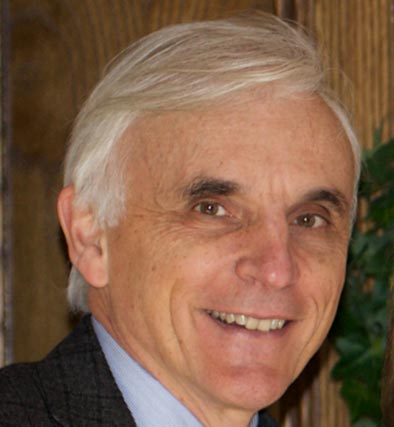
Dr. John Floras is a cardiologist at PMCC who first met Domenic over 15 years ago. (Photo: PMCC)
Dr. John Floras, cardiologist, Peter Munk Cardiac Centre recalls his patient's early days.
"I first met Mr. Ferraro in 2000 when he suffered a heart attack. He was treated at the time with thrombolytic (clot-dissolving) therapy. Resolution of the clot revealed severe underlying atherosclerotic narrowing of the involved blood vessel," he recalls.
"Although other serious medical issues emerged over the next 15 years, he did not experience another episode of heart damage. He did however, become increasingly limited by chest pain on even mild exertion, and for this reason he was referred for coronary angiography in 2011.
"This time there were no suitable targets for further coronary intervention or surgery, but there was a drug suitable as a treatment option," Dr. Floras says.
This eased the pressure on Domenic's heart until 2015 – that's when chest pain recurred even after only mild exertion.
A return to the catheterization laboratory confirmed that Domenic had developed severe narrowing of all three coronary arteries as well as the now-15-year-old stent. His treating physicians again looked at possible interventions, and also had to consider severe calcium build-up in Domenic's arteries.
Dr. Floras' only option was to recommend bypass surgery.
Enter Dr. William Stansfield, cardiac surgeon, Peter Munk Cardiac Centre.
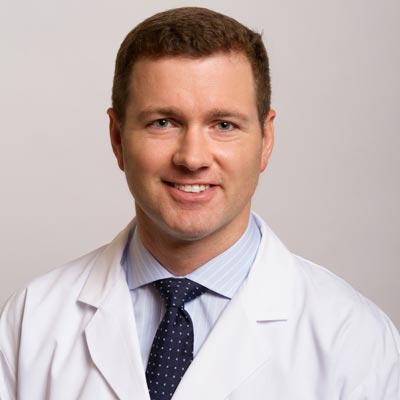
Dr. William Stansfield is a cardiac surgeon at PMCC who worked with Domenic after a referral in 2015.
"When I saw him, he had unremitting angina. He was crippled by ischemic (reduced blood flow to the heart) coronary disease," says Dr. Stansfield, who led a gruelling 13.5 hour surgery on Domenic, January 6, 2016.
"There were multiple issues during the case: a stiff heart, a bad aorta and confounding lung disease," says Dr. Stansfield.
"At each decision point, we chose the safest option. That ended up with him having had a long, complicated procedure."
At every step, the team seemed to encounter an obstacle.
"I was confident that we could get him through the surgery," says Dr. Stansfield. "But after surgery, his heart and lungs were swollen and we weren't able to close his chest until we got the swelling down several days later."
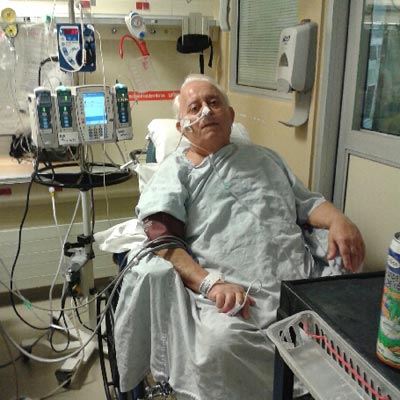
His wife by his side, Domenic spent 20 days in the Cardiovascular Intensive Care Unit (CVICU) at the Peter Munk Cardiac Centre, following quadruple bypass surgery on Jan 6, 2016. (Photo: PMCC)
An induced coma, a month in the cardiovascular intensive care unit, and a blood infection were some of the new hurdles that reared themselves in the hours and days following quadruple bypass surgery and the reconstruction of Domenic's aorta.
"Seeing him all of those days and not knowing if he would wake up or not, and fearful that he had suffered a stroke too," recalls Rosa-Alba Ferraro, through tears. "I told Dr. Stansfield, we trust you. We're in your hands."
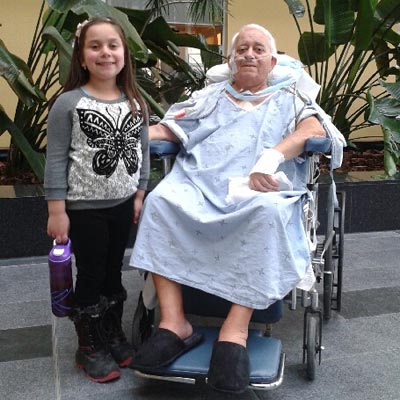
Calling her the "love of his life", Domenic's six-year-old granddaughter Sophia has made frequent visits to the hospital over the past three months, bringing her smile, humour and energy to his recovery. (Photo: PMCC)
"The medical team always had hope," says son, Sandro.
The care Domenic received at PMCC was crucial to his positive results, explains Dr. Stansfield.
"He benefitted from having many attentive doctors from surgery and the Cardiovascular Intensive Care Unit (CVICU) team, who took care of him and never gave up," Dr. Stansfield says.
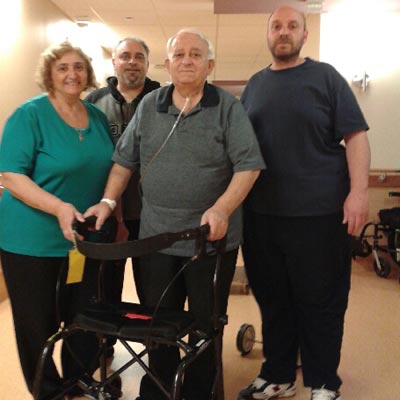
Several physiotherapists have helped Domenic back on his feet following his heart surgery and the reconstruction of his aorta. He spends one hour a day with an occupational therapist and separately with a physiotherapist as part of his stay at the Toronto Rehab Institute. (Photos: The Ferraro family)
Slowly, surely and with steely determination, Domenic began taking baby steps with his oxygen tank and breathing tube close at hand. He began walking and moving with the help of nurses, allied health professionals, respiratory therapists and his family.
He is now several weeks into a daily regimen of cardiac rehabilitation and is making great progress.
"I'm thankful to be alive," says Domenic.
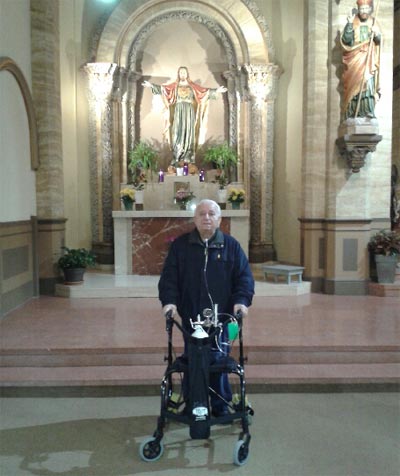
On March 12, 2016, Domenic walked to St. Patrick's Church on McCaul Street, near the Toronto Rehabilitation Institute, to hear mass. He has been in rehab at TR since Feb. 25, 2016. (Photo: the Ferraro family)
Originally slated for heart surgery just before Christmas, Domenic's procedure had been delayed until the new year, allowing him to spend the holidays with his family.
Now, three months later, with a new lease on life – leaning throughout on family and faith – Domenic celebrated the Easter season among family, friends and medical staff at Toronto Rehab.
At the same time, they are counting the days towards a healthy return home.
